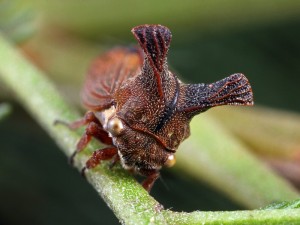Order Hemiptera

showing the more recognised bug shape.
There are something like 6,000 known species of bugs in Australia and they come in a huge variety of shapes, sizes and colours.
Within Hemiptera there are three suborders – Heteroptera (true bugs, e.g. shield bugs), Auchenorrhyncha (e.g. leafhoppers and cicadas), and Sternorrhyncha (e.g. aphids, scale insects and mealy bugs).
It is difficult to give a single description for Hemiptera as a whole because of the huge diversity. Some have two pairs of wings, some have a single pair and some have none. Heteroptera usually have two pairs, the forewings being hardened at the base and membranous at the tips, and the hindwings being uniformly membranous. A couple of species are wingless. Auchenorrhyncha have two pairs, both being membranous. Some Sternorrhyncha have only a single pair, while others are wingless.

from the family Membracidae.
They all have a pair of compound eyes and up to three ocelli, which are simple eyes believed to be more for light sensitivity rather than actual vision. There is also a pair of antennae of varying lengths.
One common feature is the sucking mouthparts, which can be used for piercing plant stems, leaves or roots and sucking out the sap, or preying on other insects, or for sucking blood (bed bugs are a well-known example of this).
The life cycle involves incomplete metamorphosis. After hatching from their eggs, the nymphs basically resemble adults and moult up to eight times until they reach maturity, sometimes over a period of many years (e.g. cicadas).
The members of hemiptera can be found all over Australia. Most live on land but a few from the Heteroptera suborder have taken to living on or just under the surface of fresh water.
This has been one of the toughest groups of insects to identify because quite a few species can appear very similar to one another. There are others that I just can’t find examples of elsewhere. Be prepared to see quite a few photos labelled “unknown”. If you do recognise any of them, I would be grateful to hear from you.
~~~~~
The Hemiptera photo galleries are divided into three sections
Click here to see the True Bug photo galleries
Click here to see the Cicada and Hopper photo galleries
Click here to see the Aphid, Scale Insect and Mealybug photo galleries
~~~~~

Special thanks to Boris Buche for his help in identifying some of these bugs. Check out his great site for Indonesian beetles at: beetle-diversity.com
And a big thank you to Murray Fletcher from the Department of Primary Industries, New South Wales, for his generous assistance with identifying many of the Hoppers. Refer to his site containing keys to identifying Hoppers and Cicadas.